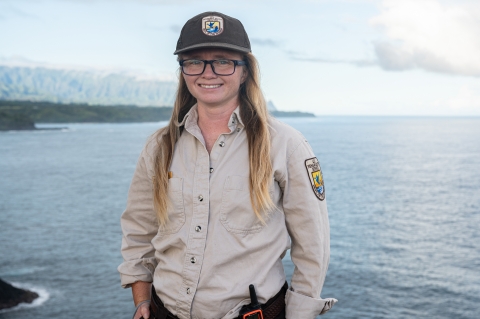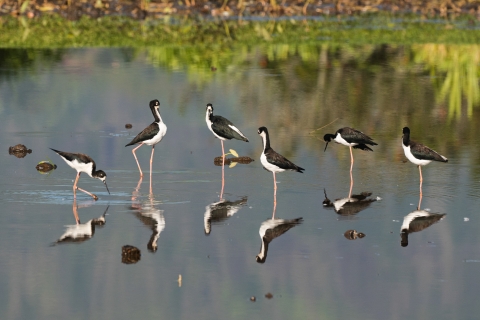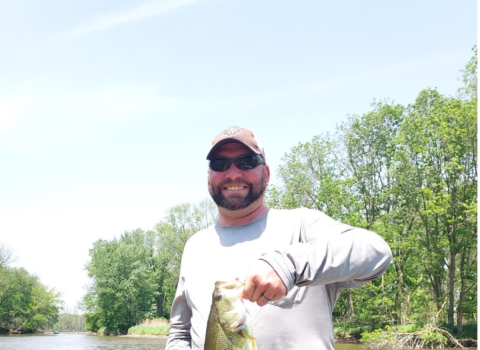Laurel Smith is a professional photographer, educator, and storyteller who works as a visitor services ranger at Kīlauea Point National Wildlife Refuge in Hawaii. She recently contributed many of her images to the U.S. Fish and Wildlife’s National Digital Library. She believes photography is one of the most powerful tools we have to educate and inspire change.
The National Digital Library, managed by the USFWS Library, is the premier source for public domain wildlife images, and home to the pictures, documents, audio, and video that tell the story of the Service. Public domain imagery is free to use, reuse, and share in any capacity. The FWS Behind the Lens blog series highlights Service employees in the field who have contributed spectacular photography with an eye toward reflecting the full mission of the Service.
Laurel has a bachelor’s degree in creative nonfiction writing from the University of Denver and an associate of science degree in professional photography from Colorado Mountain College. She is a licensed elementary school teacher and taught for multiple years. Laurel was a full-time freelance photojournalist and filmmaker focusing on people living in marginalized communities. But when the world came to a grinding halt, all her film work stopped too, so in the height on the pandemic, Laurel moved from Colorado to Hawaii for a fresh start.
She began volunteering at Kīlauea Point National Wildlife Refuge to learn and spend more time with the birds, which she quickly became passionate about. Laurel fell in love with the refuge, and when the position for visitor services ranger came up, she jumped at the chance. Until then, Laurel had never considered a career in conservation despite having spent a good portion of her adult life volunteering for environmental organizations including her service as a Natural Resource Peace Corps Volunteer in Ecuador.
“I always thought that I was a storyteller and an educator, but not a scientist. It seems obvious to me now that of course we need storytellers in conservation. As a ranger it is my job to tell the stories of our birds, our land, and our history,” Laurel explains.
She always starts her day inspired by the beauty of the point, taking care of various opening duties and greeting the birds that are out. She focuses on operations, fee collection, and working directly with visitors. Some of the highlights of her job are watching chicks and goslings grow, seeing whales and their calves swim by, and assisting the biologists with bird counts and surveys. Laurel plans her interpretations for visitors, social media, and other forms of outreach around the timing of the seasons and wildlife behaviors. She manages the refuge’s website and regularly creates content for social media and interoperative displays, like her story on The Plight of the Nēnē.
Although she has bounced around a few careers, her job as visitor services ranger seems to combine all of Laurel’s experience, education, and passions. She says, “I can’t think of a job more perfect for me, I get to create a lot at work through writing and photography.”
Her favorite thing to photograph is birds; they are fast-moving, dynamic and often unpredictable. “The perfect subject,” in Laurel’s opinion, “and turning the lens to birds has also helped me heal from the traumas of the pandemic.”
One of her favorite pictures is a close-up of the mōlī (Laysan albatross) eye. She took this photo while GPS mapping their nests last November. Mōlī live incredibly complex lives and there is so much we don’t know about them. Laurel shares, “I feel awe every time I see them. With this photo I wanted to give viewers that same opportunity to connect with these amazing animals.” Because it’s hard to choose just one, she describes her second favorite photo: an ‘iwa (great frigatebird) soaring over a rainbow. Located on the northern most point of Kaua'i, Kīlauea Point NWR has one of the largest populations of nesting seabirds in the state, which makes it a pretty magical place. Laurel says, “It is such a special spot, and I really enjoy sharing these experiences using photography.”
Laurel continues to enjoy wildlife photography and utilize her natural skills and passions for conservation. Whether she is capturing a photograph, creating an interpretive display, or talking directly with visitors Laurel hopes that her work inspires change and gives people a reason to want to protect our wildlife, their habitat and rich native cultures that have flourished in these wild spaces for centuries. Visit our National Digital Library to find thousands of public domain images. Brought to you by the USFWS Library, #FWSBehindTheLens, #WeAreUSFWS.










